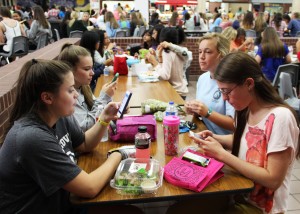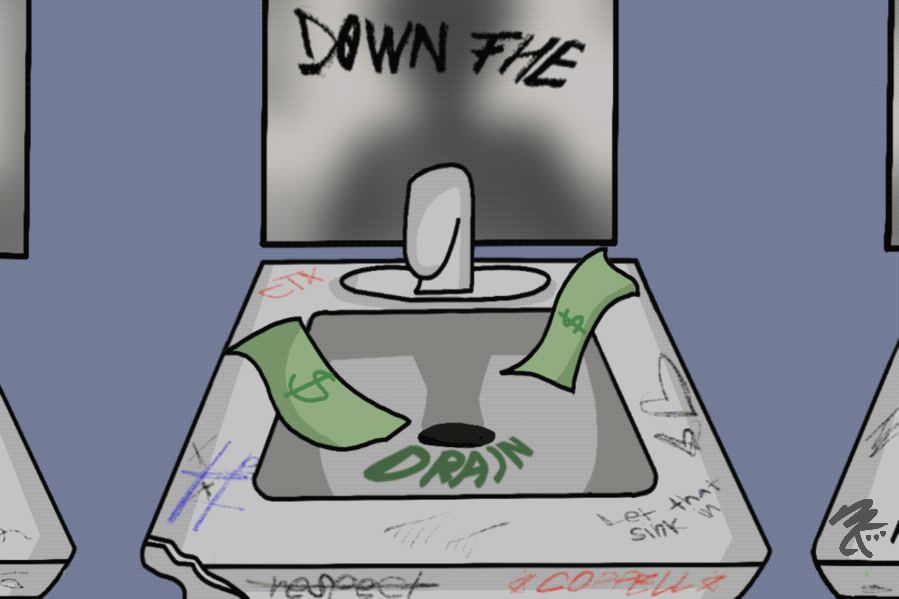By Kristen Shepard
Editor-in-Chief
It is a Saturday night in the middle of summer. A group of nine of my friends and I sit around a table at Parma’s Italian Restaurant to celebrate a friend’s birthday that we have been planning to celebrate together for weeks. Everything about the night leads to a potential for a great time, but only one thing is wrong: every single person is looking at their iPhone.
Now, this was not a quick text to Mom or a glance at an email. This is, in fact, full on, heavily involved and ridiculous interaction with our cell phones as the birthday girl sits at the head of the table awkwardly waiting to be acknowledged.
Finally, after the waiter has dropped by our table twice, the girl to my left slaps her phone down onto the table and tells me to stack mine on top. We pass this command down the table, and after about 45 seconds, every iPhone is stacked in a neat pile in the center of the table.

catch up on social media while junior Kaylee Geiser attempts to catch up with her friends. Photo by Nicole Messer.
The idea is that, if everyone’s phone is in the middle of the table, then no one can start an epidemic of staring at the ever so addicting LED screens. Let me tell you, it was like we were new people. Almost instantaneously, conversation exploded. We laughed (and complained) about our summer job adventures, listened to each others’ stories of trips to Europe and gushed about the shocking Season 5 finale of “Gossip Girl”.
Conversation was flowing was so naturally, I could not help but ask “What were y’all doing on your phones anyways?”
Silence followed. Then a series of unfortunate, awkward shrugs made us realize: we really were not doing much of anything. Our cell phone use was not a necessity, no one was texting their doctor about an emergency, or drafting a paper or reading an article on CNN. We were simply doing nothing. We had completely taken for granted the fact that we were finally all together in the same place, and instead, were mindlessly checking Instagram and playing Candy Crush.
Cell phone use in social interactions used to be an etiquette horror story, and the thought of bringing a cell phone into an important meeting or classroom was not only far-fetched, but absurd. Now, as cell phones have made their way into our professional interactions, they have inched their way into our social interactions. No, the presence of cell phones in social gatherings has skyrocketed, changing from the occasional glance to a full-on substitute for conversation.
It is not that my group of friends was too consumed with more important business, or that we did not appreciate our friend’s birthday, we simply were not thinking of how uncomfortable the whole situation was.
The same situation panned out at an assembly Coppell High School had last Thursday. When former Dallas Mavericks coach Avery Johnson came to present about goal setting and the keys to success, until he ever so boldly demanded that everyone put their phones away, a sickeningly large proportion of our student body sat and looked down at their phones.
Though a basketball-playing male student may be much more receptive than the average female student, our school was far from welcoming. It was not until the electronics made their way under the seats that the student’s started becoming engaged in the assembly. Students formed their own opinions about Johnson and listened to his points, whereas the hour they spent favoriting celebrity tweets would not have offered them anything, except the possibility of a new high score.
Cell phones are ideally a powerful resource. The sheer amount of information that can be gathered from them makes them useful for both convenience and security. With a few swipes, taps and clicks, one can check the weather, the news or even a friend’s location. But with great power comes great responsibility, and students have the responsibility to put their interactions and etiquette above mindless games and social networking.








